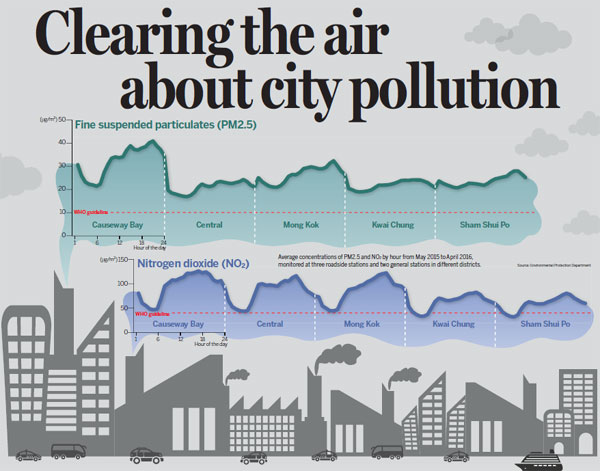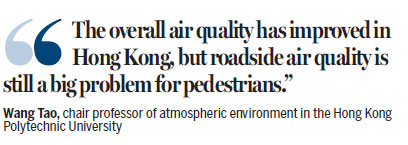Clearing the air about city pollution
Updated: 2016-09-14 06:54
By Sylvia Chang(HK Edition)
|
|||||||
More people die from exposure to toxic air than smoking in HK. A more advanced air-monitoring system could help reduce the number of such fatalities, Sylvia Chang reports.
It might seem Hong Kong is much better off than Beijing when it comes to environmental pollution. While the world is familiar with images of a smog-encapsulated Beijing, one doesn't see comparable pictures of Hong Kong, carrying apocalyptic implications, in the media. Recent scientific evidence suggests Hong Kong's air quality is still a big problem, containing high levels of pollutants that could cause chronic diseases, such as lung cancer.
China Daily crunched data collected over a year, beginning May 2015, from air quality monitoring stations in 16 districts of the city, noting the hourly average concentration of fine suspended particulates known as PM2.5, and nitrogen dioxide (NO2) - two among the pollutants linked to health hazards. The investigation shows how the levels of pollution vary at different times of the day. An analysis of these patterns might lead us to significantly reducing pollution levels.
Above WHO levels
As the chart shows, in general, the concentration of the two pollutants in air are much higher during the day compared to night time. The levels are also higher during rush hours, i.e. between 8 and 10 am, than during the rest of the day.
The concentration of PM2.5 in all districts is almost one time above the World Health Organization (WHO) air quality guideline (10 g/m) throughout a day. The WHO guideline values, known as the annual average limit, are based on solid scientific evidences relating air pollution to the health hazards they are likely to cause.

In the daytime, the concentration of NO2 in most districts exceeded the WHO guideline (40 g/m). The levels in the three roadside monitoring stations, located in traffic-concentrated areas, are extremely high, higher by 250 percent in some cases.
"The overall air quality has improved in Hong Kong, but roadside air quality is still a big problem for pedestrians," said Wang Tao, chair professor of atmospheric environment in the Hong Kong Polytechnic University (PolyU).
Apart from concerns of high concentrations of PM2.5 and NO2, Wang noticed that the higher level of ozone "is a persistent problem despite local control efforts". He urged the government to keep controlling vehicle emissions and conduct more research to confirm the reasons causing ozone levels to rise.
Sources of pollutants

The major sources of PM2.5 and NO2 in Hong Kong are exhausts from diesel vehicles, marine vessels and power plants. Long-term exposure to these pollutants increases the risks of developing heart and respiratory diseases, such as asthma and bronchitis.
According to air quality monitoring station readings, Tuen Mun, Yuen Long and Sham Shui Po have the highest PM2.5 concentration in Hong Kong, while Kwai Chung, Sham Shui Po and Tsuen Wan have recorded the highest NO2 concentration.
These results basically reflect the impact of emissions from vehicles and marine vessels, according to professor Wang of PolyU. The districts of Tuen Mun, Yuen Long, Sham Shui Po, being focused on urban renewal, are sites of intensive construction of private buildings, leading to air pollution. Kwai Chung and Tsuen Wan are located near container ports through which marine vessels pass by frequently.
Apart from these sources, weather and topography of a particular area also contribute to air pollution.
Heavy health burden
A local real-time system, Hedley Environmental Index, designed by the School of Public Health in the University of Hong Kong (HKU), indicates in 2015, 1,187 patients of cardiovascular diseases died of air pollution in Hong Kong. The number of such fatalities is 21 times more than that from traffic accidents.
Air pollution last year also caused 1,298 deaths of those suffering from respiratory diseases, accounting for 9.6 percent of the entire medical expenditure. It was also the reason behind 273 deaths from chronic obstructive pulmonary diseases, 43 percent higher than those who died of smoking.

Emerging research has shown links between high level of PM2.5 and health risks. According to Thuan Quoc Thach, scientific officer in the School of Public Health of HKU, "If a person is continuously exposed to PM2.5 for years, for each increase of 10 g/m in PM2.5 concentration, the risk of dying from any cancer is increased by 22 percent."
The charts complied by China Daily show that the annual mean of PM2.5 concentration in most districts of Hong Kong is above 20 g/m, i.e. twice the limit set by WHO. Therefore, according to Thach's study, in Hong Kong the risk of dying from cancer for is 22 percent higher than those in cities where the PM2.5 concentration is level with or below the WHO standard.
Thach's study also shows that for women exposed to polluted air, every 10 g/m increase of PM2.5 means an 80 percent increased risk of mortality from breast cancer, while for men similar exposure would means a 36 percent increased risk of dying of lung cancer.
Outdated official index
The city's official air monitoring system, known as the Air Quality Health Index (AQHI), provides an integrated air quality guide and basic health suggestions.
The rules of AQHI are based on local health studies on cumulative health risks relating to average concentrations of air pollutants. The standards, however, are less strict than the WHO's guideline.
"It (AQHI) fails to reflect a comprehensive understanding of health hazards to the exposure of air pollution under the current knowledge," said Simon Ng, chief research officer on environment in Civic Exchange, a think tank on the development of air quality, nature conservation and urban environment.
WHO says the safety level of PM2.5 is 10 g/m for annual average concentration, the lowest level at which cardiopulmonary and lung cancer mortality will increase in response to long-term exposure to PM2.5.
The AQHI, however, sets the figure at 35 g/m, three times lower than the WHO guideline, indicating a 15 percent higher long-term mortality.
The concentration of sulphur dioxide, Ozone and PM10 in Hong Kong air is also far from the long-term goal of WHO.
A further problem is that the AQHI monitors only short-term results, three-hour moving average concentrations of air pollutants, and provides general precautions to prevent health problems.
"This may be useful for people who already have heart or respiratory illnesses and would feel immediate discomfort when pollution rose to a certain level. But it lacks the ability to alert people about the risks of long-time exposure in an unhealthy air which could cause chronic diseases," said Ng.
Different from the AQHI, the Hedley Index of HKU is based on the ultimate goal of the WHO. "The aim (of designing the Hedley Index) is to provide an accurate and reliable measure of risks to members of the public," said Thach of HKU.
At current stage, about 1,500 visitors per month click into the website system of Hedley Index. A mobile application is under development for a larger population to access, Thach said.
Contact the writer at
sylvia@chinadailyhk.com
(HK Edition 09/14/2016 page8)